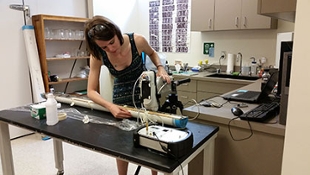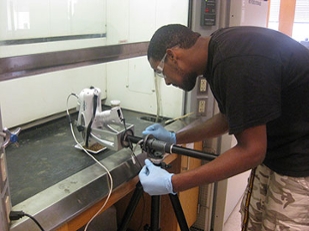How new spectrometer technology is revolutionizing research at JMU
NewsSUMMARY: For Nash, an associate professor of integrated science and technology, the XRF is enabling her to do archaeological work without destroying specimens.

JMU faculty and students routinely use cutting edge technology in well-equipped laboratories.
A hand-held spectrometer was recently added to the inventory, though it doesn't look so cutting edge. In fact, you could almost mistake it for a hairdryer. Dr. Carole Nash and Dr. Robert Brent are a little more complimentary of its appearance, saying it looks more like the phasers used in Star Trek.
While the handheld X-ray fluorescence (XRF) analyzer may or may not look space age, it is delivering the convenience, flexibility and educational opportunities the researchers sought.
For Nash, an associate professor of integrated science and technology, the XRF is enabling her to do archaeological work without destroying specimens. Nash is studying the movements of Native Americans along the Blue Ridge Mountains by locating the stone tools they used and carried with them from place to place. The artifacts are made of quartzite, a "beautiful white material," she said, that is found all along the base of the Blue Ridge from southern Virginia to Front Royal.
Using the artifacts to trace the movements of the people requires getting a chemical signature of the artifact and then matching it to the chemical signature of where it was quarried. Before getting the handheld spectrometer, that meant sending the specimens away to a lab where they would be crushed to get the required data.
With the XRF, Nash said, "We can get chemical signatures for the different outcrops we know were used by Native people, and then we can take those artifacts that are found in other places, zap them and match them up."
In addition to saving the specimens, the handheld spectrometer saves a lot of time by making the data readily available. Another benefit, Nash said, is students get to use it. "This is something that is very specialized. Typically when you get something like this, you’re very careful about who gets to use it and we want our students to train on it because this is an emerging technology.
"The way it works, it’s a very simple principle. You shoot an x-ray at the material you’re trying to identify. Every element has a specific kind of chemical energy in its bonds. When those bonds are broken, the energy is released. The energy that comes back from intersecting an x-ray with magnesium is different than copper. So it allows you to identify elemental content."
The spectrometer requires some training to use, especially calibrating it and interpreting the results, Nash said. "As with any technology like this where you have so many variables that you have to consider, it just takes a lot of practice."
The time the XRF saves in getting results is a big plus for Brent, an associate professor of integrated science and technology, who is researching levels of mercury in the South River at Waynesboro and helping remediate the situation. The river has been polluted since the late 1920s when a DuPont plant used the chemical in its manufacturing process. Although the plant has not used mercury since 1950, it still fouls the banks of the river and when the water rises to the level of the polluted areas, it washes back into the water.
Brent is using the spectrometer to test soils removed from various locations of the riverbank. So far, he has used it in his lab at JMU, testing soil already tested by DuPont and comparing the results. "We saw really promising results," Brent said. "About 51 samples that we compared between the two laboratories had very good agreement."

Brent plans to use the XRF in the field this spring. "Being able to make real-time decisions in the field, particularly if you’re in the middle of a remediation and you’re digging out mercury, you want to know you got it. If you can make those decisions in the field you can save quite a bit of time and money," he said.
Like Nash, Brent said his students are using the device.
Because the $50,000 price tag of the spectrometer and its accessories was a little steep for one department, Nash pooled funds with the department of geology and environmental science, and the College of Visual and Performing Arts. Dr. Kate Stevens, director of the Madison Art Collection and an assistant professor of art history, has been using it for a number of tasks, including identifying the materials used in various pieces; authenticating ancient coins; and determining the location of manufacture for Mesoamerican terracottas.
"Doing all of these things before getting the handheld spectrometer was difficult," Stevens said. "We had access to the SEM (scanning electron microscope), but the chamber is very small and we prefer not to damage or destroy our objects for testing purposes. The XRF is non-invasive, non-destructive and you pin-point areas of analysis."
Four geology students have used the XRF for their senior research projects and presented their results at the national meeting of the Geological Society of America in fall 2015, said Dr. Kristen St. John, professor of geology and environmental science. The students — Cari Rand, Julie Nawiesniaik, Caroline Robinson and Kelsea McKinley —attended training on the device during the spring 2015 semester.
Another eight students trained on the device in the fall 2015 semester as part of their paleoloclimatology and paleoceanography course (Geol 406). The students are working with sediment cores taken from the Gulf of Mexico to learn about historical climate change.
The XRF has so many uses and is becoming so popular that the researchers hope to add more of them.
"The thing that’s cool about the technology is every person who uses it has the potential to show something different about what it can do," Nash said. "So we’ve been working with Bruker, the company that makes it, to let them know what we’re doing, and they’re getting pretty excited about some of our findings."
By Rachel Petty ('17), Communications & Marketing

